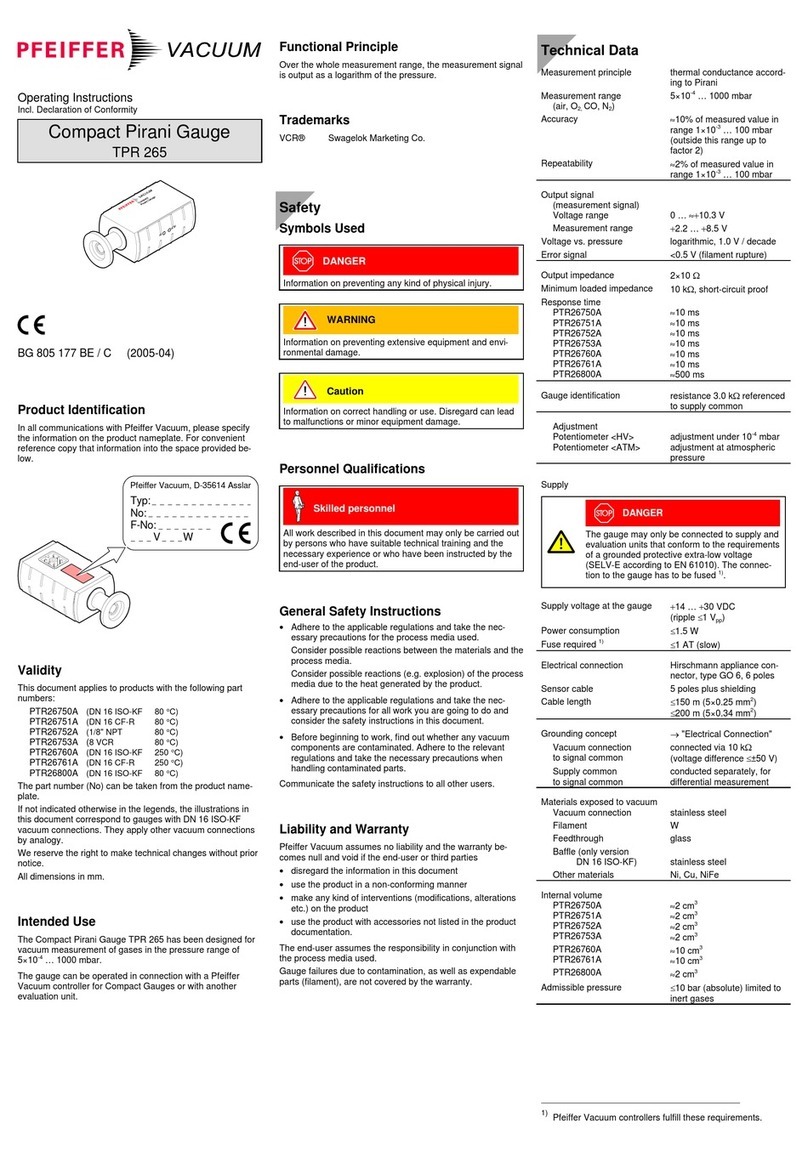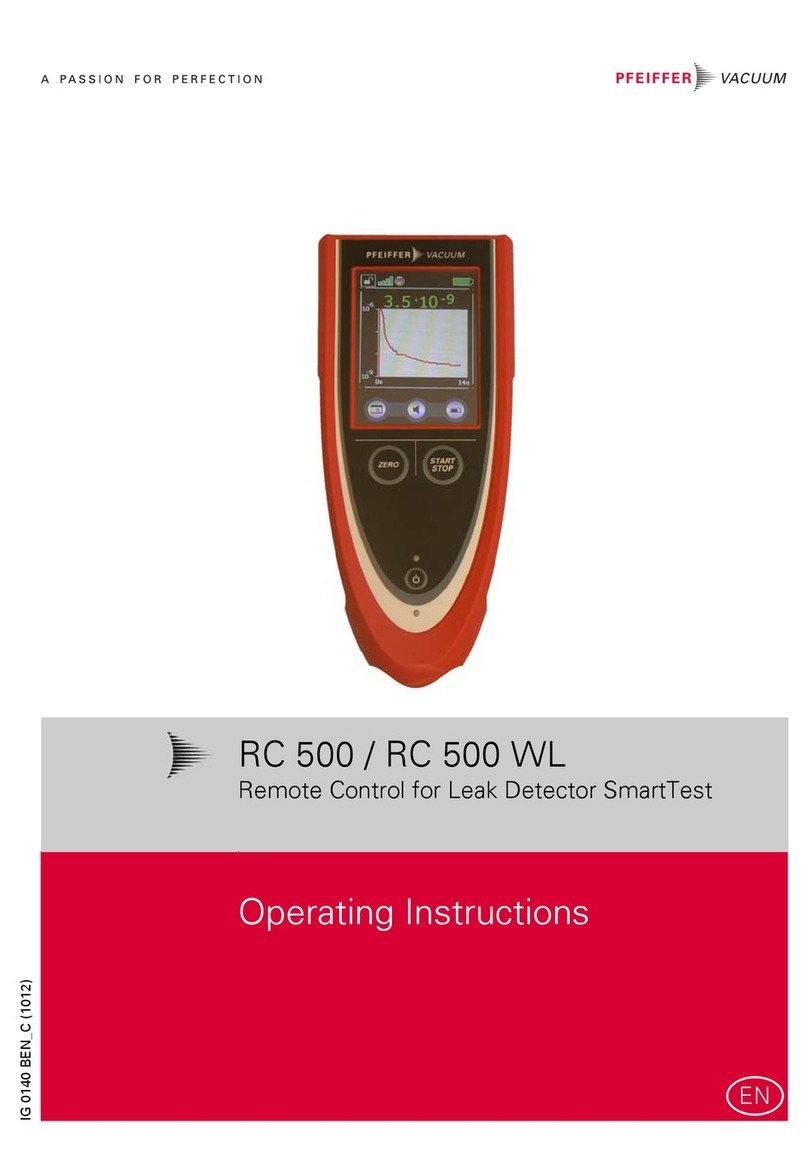Operating Instructions
Incl. Declaration of Conformity
Compact Pirani Gauge
TPR 280
TPR 281
BG 805 178 BE / D (2006-02)
Product Identification
In all communications with Pfeiffer Vacuum, please specify
the information on the product nameplate. For convenient
reference copy that information into the space provided
below.
Typ:
No:
F-No:
V W
Pfeiffer Vacuum, D-35614 Asslar
Validity
This document applies to products with the following part
numbers:
TPR 280
(W filament)
TPR 281
(Ni filament)
PTR26950
PTR26951
PTR21950 (DN 16 ISO-KF)
PTR21951 (DN 16 CF-R)
PTR26960
PTR26961
PTR21960 (DN 16 ISO-KF long tube)
PTR21961 (DN 16 CF-R long tube)
The part number (No) can be taken from the product name-
plate.
If not indicated otherwise in the legends, the illustrations in
this document correspond to gauges with DN 16 ISO-KF
vacuum connections. They apply other vacuum connections
by analogy.
We reserve the right to make technical changes without prior
notice.
All dimensions in mm.
Intended Use
The Compact Pirani Gauges TPR 280 and TPR 281 have
been designed for vacuum measurement of gases in the
pressure range of 5×10-4 … 1000 mbar.
The gauges must not be used for measuring flammable or
combustible gases which react in air.
They can be operated in connection with a Pfeiffer Vacuum
controller for Compact Gauges or with another evaluation
unit.
Safety
Symbols Used
DANGER
Information on preventing any kind of physical injury.
WARNING
Information on preventing extensive equipment and envi-
ronmental damage.
Caution
Information on correct handling or use. Disregard can lead
to malfunctions or minor equipment damage.
Personnel Qualifications
Skilled personnel
All work described in this document may only be carried
out by persons who have suitable technical training and
the necessary experience or who have been instructed by
the end-user of the product.
General Safety Instructions
•Adhere to the applicable regulations and take the nec-
essary precautions for the process media used.
Consider possible reactions between the materials and the
process media.
Consider possible reactions of the process media due to
the heat generated by the product (e.g. explosions).
•Adhere to the applicable regulationsand take the neces-
sary precautions for all work you are going to do and
consider the safety instructions in this document.
•Before beginning to work, find out whether any vacuum
components are contaminated. Adhere to the relevant
regulations and take the necessary precautions when
handling contaminated parts.
Communicate the safety instructions to all other users.
Liability and Warranty
Pfeiffer Vacuum assumes no liability and the warranty be-
comes null and void if the end-user or third parties
•disregard the information in this document
•use the product in a non-conforming manner
•make any kind of interventions (modifications, alterations
etc.) on the product
•use the product with accessories not listed in the product
documentation.
The end-user assumes the responsibility in conjunction with
the process media used.
Gauge failures due to contamination, as well as expendable
parts (filament), are not covered by the warranty.
Technical Data
Measurement principle thermal conductance according
to Pirani
Measurement range
(air, O2, CO, N2)
5×10-4 … 1000 mbar
Accuracy (N2)
1×10-3 … 100 mbar ±15% of reading
5×10-4 … 1×10-3 mbar ±50% of reading
100 … 1000 mbar ±50% of reading
Resolution 1% of reading
Repeatability with air
1×10-3 … 100 mbar 2% of reading
Output signal
(measurement signal)
Voltage range VDC 0 … +9.0
Measurement range VDC +2.2 … +8.5
Voltage vs. pressure logarithmic
1.0 V/decade
Error signal V 0 … +0.5
(filament rupture)
Output impedance Ω2×4.7
Minimum loaded
impedance
kΩ10, short-circuit proof
Response time ms 80
Gauge identification 3.0 kΩ, referenced to supply
common (voltage at pin 1 ≤5 V)
Adjustment one tactile switch for ATM and
HV adjustment
Supply
DANGER
The gauge may only be connected to power
supplies, instruments or control devices that
conform to the requirements of a grounded
extra-low voltage (SELV-E according to
EN 61010). The connection to the gauge has to
be fused 1).
Supply voltage
At gauge VDC +14 … +30
Ripple Vpp ≤1
Current consumption mA <500
(max. starting current)
Power consumption W ≤1
Fuse required 1) AT
(slow)
1
Electrical connection Hirschmann appliance
connector, male,
type GO 6, 6 poles
Sensor cable 5 poles plus shielding
Cable length ≤150 m (5×0.25 mm2)
≤200 m (5×0.34 mm2)
Grounding concept →"Electrical Connection"
Vacuum connection to
signal common
connected via 1 MΩ
(voltage difference <15 V)
Supply common to
signal common
conducted separately, for
differencial measurement
Materials exposed to
vacuum
DIN 1.4301, DIN 1.4305,
DIN 1.4435, glass, Ni,
NiFe
Filament
PTR26xxx
PTR21xxx
W
Ni
Internal volume
PTR26950, PTR21950
PTR26951, PTR21951
cm3
cm3
≈1.5
≈1.5
PTR26960, PTR21960
PTR26961, PTR21961
cm3
cm3
≈10
≈10
Admissible pressure bar
(abs.)
10, limited to inert gases
1) Pfeiffer Vacuum controllers fulfill these requirements.























